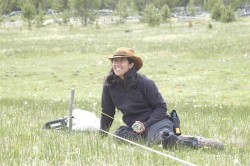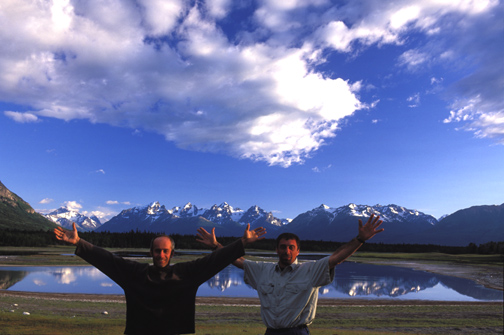
Guess ah...a while back, I’m not sure when that was... I happened to visit in
Nemiah. But [names elder and his wife] told me what he saw when they opened the
door to the east. They live in a small log cabin. And they open the door. And way up
in the sky they saw horses trailing, one after another into the sky. The horses’ spirit.
(Quote from "Knowing Naŝlhiny")
Research & Readings
Since 2001 Friends of the Nemaiah Valley (FONV) has engaged in a variety of primary research projects. We have funded and hired our own consultants and we have funded and provided support services for independent researchers, including graduate students.We are interested in projects that advance knowledge that will be useful in supporting our primary goals of protection of the environment in combination with a healthy and thriving human community within that environment.
All research funded by FONV is made available to the Xeni Gwet'in people in accordance with our protocol agreements. Independent researchers are encouraged to follow this lead when working in Tsilhqot'in sovereign territory.
Reports 2014:
Bhattacharyya, J. & Larson, B.M.H. (2014). “The Need for Indigenous Voices in Discourse about Introduced Species: Insights from Controversy over Wild Horses.” Environmental Values 23(6): 663-684. http://www.erica.demon.co.uk/EV/EV2327.html
Bhattacharyya, J., Baptiste, M., Setah, D. & William, R. (2012) “It’s Who We Are: Locating Cultural Strength in Relationship with the Land.” In John Parkins & Maureen Reed (Eds.) The Social Transformation of Canada: New Insights into Community, Culture and Citizenship. Vancouver: UBC Press. http://www.ubcpress.ca/search/title_book.asp?BookID=299173841
Bhattacharyya, J., Slocombe, S. & Murphy, S. (2011). “The ‘Wild’ or ‘Feral’ Distraction: Effects of Cultural Understandings on Management Controversy over Free-Ranging Horses (Equus ferus caballus)” Human Ecology: An Interdisciplinary Journal 39(5): 613-625. (DOI) 10.1007/s10745-011-9416-9. http://link.springer.com/article/10.1007/s10745-011-9416-9
Bhattacharyya, J. (2012). Knowing Naŝlhiny (Horse), Understanding the Land: Free-Roaming Horses in the Culture and Ecology of the Brittany Triangle and Nemiah Valley. Doctoral Dissertation, School of Planning, University of Waterloo, ON.
https://uwspace.uwaterloo.ca/bitstream/handle/10012/6521/Bhattacharyya_Jonaki.pdf
Wild Horse DNA report
2013: Following papers were funded by and prepared and presented to the independent CEAA Panel hearings re the proposed "New Prosperity" open-pit gold and copper mine on behalf of the Friends of the Nemaiah Valley:
Final Report filed by Wayne McCrory, RPBio, to Federal Review Panel on Taseko Mines' proposed New Prosperity Mine on impact to Grizzly Bears: "......in terms of reliance on mitigation and cooperative monitoring measures with the province, including a Grizzly Bear Mortality Risk Reduction Plan that will be devised within 6 months if the mine is approved, this also represents a continuum of misclaims by Taseko of insignificant adverse impacts on grizzly bears and proposed mitigation measures that have been not been proven to be effective with respect to identified significant adverse cumulative environmental effects on grizzly bears from traffic mortality."
Cultural and Social-Ecological Significance of the Region Surrounding Teztan Biny. Dr. Jonaki Bhattacharyya
Cumulative Impact, Watershed Values and Sustainability. Dr. Karen Hurley
Potential Costs to Public Road System from Truck Transport of Mine Concentrate. Don MacKinnon, P.Eng
Impact Of New Prosperity Mine on Aboriginal Title and the Duty to Consult. Dr Marc Pinkoski
Xeni Gwet'in FNG Development Vision and the Implications of New Prosperity Mine. John Lerner
And here are the Friends of the Nemaiah Valley Closing Remarks made to the panel on the final day of the hearings.
 "Knowing Naŝlhiny (Horse), Understanding the Land: Free-Roaming Horses in the Culture and Ecology of the Brittany Triangle and Nemiah Valley" (2012).
"Knowing Naŝlhiny (Horse), Understanding the Land: Free-Roaming Horses in the Culture and Ecology of the Brittany Triangle and Nemiah Valley" (2012).Dr.Jonaki Bhattacharyya has visited the Brittany Triangle a number of times over the past six years, making many strong friendships among the Xeni Gwet'in FN and being open to their teachings.
"Free-roaming horses (Equus ferus caballus L.) – also called wild or feral – have been present in the Chilcotin region of British Columbia, Canada and part of Tsilhqot’in First Nations’ culture for over 250 years. The horses, naŝlhiny in Tsilhqot’in, have also been a focal point for controversy and power struggles over land use in the same region for at least 120 years. Recently, the wild horses of the Brittany Triangle (called Tachelach’ed, near the Nemiah Valley in the territory of the Xeni Gwet’in First Nation) have been used by local First Nations and some non-governmental organizations as an iconic symbol to gain support for wilderness conservation. To some other residents and government agencies, free-roaming horses are invasive pests that threaten forage availability for cattle, range health, and native wildlife habitat. Little peer-reviewed research exists to elucidate the actual ecological impacts and social relationships of free-roaming horses in the particular ecological, cultural and political context of the Brittany Triangle, or to support management decisions concerning the horses.
"This research explores how scientific analysis, local knowledge, and socio-cultural perspectives regarding the ecology and cultural role of free-roaming horses in the Brittany Triangle can be integrated to inform conservation planning and land use management."
 Assessing Stakeholders' Interests: A Strategy for Best Management Practices of Free-Roaming Horses, Chilcotin, British Columbia (2010) by Katherine Card, B.A., M.A.
Assessing Stakeholders' Interests: A Strategy for Best Management Practices of Free-Roaming Horses, Chilcotin, British Columbia (2010) by Katherine Card, B.A., M.A.Katherine Card came to the Chilcotin (Tsilhqot'in) to complete field work for her Master's degree in Natural Resources Management at the University of Manitoba.
The Masters thesis presented here is the result of a series of interviews she conducted following her work in the Brittany that were designed to ascertain rancher, First Nations, and other stake-holder attitudes toward the wild/free roaming horses of the the district.
 "Mustang Valley" (2004) Andrew Findlay and Patrice Halley (photographer)
"Mustang Valley" (2004) Andrew Findlay and Patrice Halley (photographer)"The horse stirs and tosses its head anxiously, its muscular body chestnut - brown save for a white stripe running down the length of its snout like a couloir of snow. Chief Roger William adjusts the saddle cinch in silence, slips a boot into the stirrup and hoists himself into the saddle. A gust of dry air blows down the valley, rattling the aspens and shimmering the pine grass in golden waves, while two ravens soar on a thermal, riding up the crumbling sedimentary flanks of Mount Nemaiah before resolving into black dots against the blue sky.
"If William is nervous about the mountain race about to begin, it doesn’t show or, at least, he is keeping his emotions well concealed behind mirror red sunglasses. The 39-year-old chief of the Xeni Gwet’in has ridden his quarter horse Morgan to victory in the legendary race five times. The only other competitors this year are Terry Lulua, a veteran mountain racer, June Cahoose, a steely-nerved young woman from Anahim Lake, and George Anderson, a brash tobacco-chewing Carrier from Quesnel, B.C., whose constant chatter betrays his nerves." (excerpt from "Mustang Valley")